by aramatzne@gmail.com | 16 Sep 2017 | Roads Taken
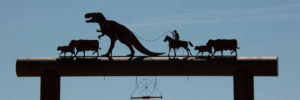
Honey! Look what I found. Can I keep it?
Long ago and far away in a land often forgotten, a biologist spent long days hiking. Uphill. Downhill. Cross slope. Through Ponderosa pines, over talus fields. Through native grasses, and evil invasive cheatgrass. Many miles were covered daily.
Every day was an adventure. Rattlesnakes, elk, buffalo, and pronghorn were regular companions, coyotes, badgers, bears, and bighorn sheep fond acquaintances. Mountain goats were a special treat.
Finding elk and mule deer antlers was common. Occasionally, a dead animal was found. Sometimes the animal was partially covered, cached by a bear or a mountain lion.
One day the biologist stumbled upon a skull. It was intact, and it was beautiful. The bone was bleached white, the teeth all in place, and the horns undamaged. It was a bighorn sheep skull. A ram. The full curl of the horns had heft and weight.
As biologists are wont to do, she collected the skull. Pulling the horns off the bony sheath allowed the skull to fit into her backpack. The horns though had to be carried by hand; they weighed a ton.
The biologist knew that possessing a bighorn ram skull was against the law. Undeterred, she packed the skull uphill, across the flat, down the slope, up the draw, finally arriving at her truck. A U.S. government issue pickup.
The skull, now unpacked from her backpack, rested neatly in the extended cab, under a blanket, where it spent the night. Ending her work day an hour after everyone else had its advantages.
Starting her work day an hour before everyone else also had its advantages. In the morning, the biologist parked her car next to the government truck and transferred the skull and the horns.
A long day of hiking passed slowly. The anticipation of setting the skull in its new home was a bit overwhelming. Finally, the work day ended, and the biologist drove home.
“Hi, honey! You’ll never guess what I found?”
“Hints? Wait. Where is it?”
“In the trunk of the car.”
“Take it back.”
“But…”
“No.”
“But…”
“Take it back.”
“You don’t know what it is.”
“If it’s still in the trunk of your car, I know what it is. Without a plug, you’ll be arrested.”
“Who’s going to know?”
“I will. Take it back. ”
The next morning, the biologist, drove to work and, arriving an hour ahead of everyone else, moved the pieces, with great reluctance. She reassembled the skull, the jaw, and the beautiful full curl horns on a desk at the US Department of Interior Fish and Wildlife Service, National Wildlife Refuge headquarters.
And acted as if nothing had ever happened.
It was just a skull. Imagine if I had roped a T. rex on the range and taken it home.
It followed me home. Can I keep it?
Like this:
Like Loading...
by aramatzne@gmail.com | 15 Sep 2017 | Musing
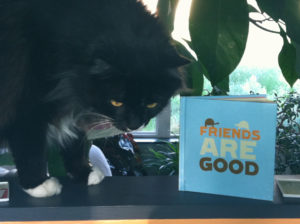
Little Cat recommends her favorite book.
I took this photo; it needs no explanation.
Like this:
Like Loading...
by aramatzne@gmail.com | 14 Sep 2017 | Musing
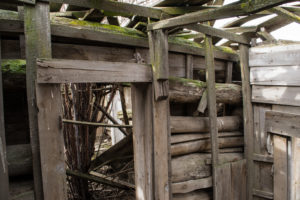
There was no display of huge teeth or horrible monsterness.
Abandoned buildings have long held intrigue for me. Who built them and why did they leave? Where did the builders come from and how did they get there – were they escaping hardship elsewhere or pursuing the dream of their own land? Did they arrive by wagon train or on foot? Where did they go? Did they die in some tragic pioneer episode – botulism or a massacre? Did the wind or the loneliness drive someone mad enough to murder their family and walk off into the winter? Perhaps a more pleasant scenario, a bachelor farmer married the love of his life and moved to town. Or the family outgrew the honeymoon house and built a new home closer to water or in a more protected location. The possibilities are endless.
Then, of course, there is Monty Python. Yes, I know this sounds like a non-sequitur. Remember in Monty Python and the Holy Grail when they arrive at the cave where the Grail’s location is written on the wall? The cave is guarded by a most horrible monster with huge teeth.
As the knights sneak up to the cave and look upon the entrance they see a rabbit quietly grazing. The knight, aghast at the idea of fearing a rabbit, berates his squire, “You bloody tit! It’s a bunny rabbit.” The assault on the cave does not go well but eventually the knights prevail, the rabbit is slain, and the final words of the dying man who wrote the location of the grail are revealed. “The holy grail is in the castle of Aaaaaaaaaaah.” Unable to complete the sentence before dying, the man merely wrote his last gasp rather than the castle’s name.
This still makes me laugh. And I still quote this movie more often than I care to admit. I mean, sometimes it’s just necessary to exclaim, “She turned me into a newt!”
Right. Abandoned buildings. I often trespass. It’s not always intentional and it’s certainly never in the form of walking up to someone’s house and peering through the windows. Unless, of course, the house happens to be abandoned.
I’m fascinated by the construction, by the things left behind, the things that have moved in, the sounds, the views through the missing windows or the leaning doors, even the smells. I’ve found whole barn owl families, pack rats, phoebes, barn swallows, cows, horses, and trees living in abandoned houses, stoves with pots on them, closets with clothes still hanging, curtains at the windows, and pantries with dishes, bottles, and tins.
As I debated whether this particular building was too far from the road for relatively unobtrusive trespassing, a pickup stopped, the driver rolled down the window and told me I was welcome to take a look. Dilemma solved.
It was built with logs and had been expanded, the stacked logs of one structure butted against the cut logs of the addition. The roof had mostly collapsed and an elderberry shrub grew in the middle of a room up through the roof joists. Shreds of wallpaper hung in a few ragged sections – it was cloth with frayed edges and a delicate, pale green leafy pattern still visible.
There was a door between the old section with the log cabin-style stacked corners and the more recent addition. Picking my way through the litter on the floor and ducking under the fallen logs, I stepped through the door and slowly turned to view the whole room, to look out of the windows, to look back into the old house.
And then I saw that I was not alone.
A shiny black bunny eye and twitchy nose were the only giveaways. Perfectly colored and absolutely still, there was no display of huge teeth or horrible monsterness. Just a bunny hanging out above a door in an abandoned house. But… how did it get there? Where did it come from? Did its family get too big and expand into this new home? Maybe it was a bachelor bunny courting a cute girl bunny in a downstairs condo. And who knew rabbits could climb walls?
I took this photo for the sheer delight – it is not often you find a rabbit watching from above a door frame. There was no evidence of rabbit viciousness but, sadly, also no scrawled note telling me who the people were or where they had gone.
Like this:
Like Loading...
by aramatzne@gmail.com | 13 Sep 2017 | Musing
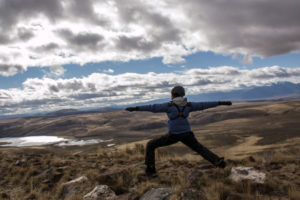
Warrior II fashion: snow pants, Sorels, and a hard hat.
The US yoga industry has exploded in recent years: hot yoga, power yoga, radiant flow, restorative, aerial, zen bootcamp (huh?). As the yoga possibilities have expanded, so too have the clothing opportunities. From its perhaps simplistic origins to a $27 billion industry in 5000 short years. No, wait. That should be 4990 years of yoga and 10 years of booming industry.
Being outdoors all day, in one place, in the cold requires warm clothing, a massive quantity of fuel to stay warm (hot chocolate with heavy cream and butter, please), and enough movement to create heat without sweating.
Enter yoga.
Over the years, the fashionable yoga set has moved away from the simple, but ever elegant, loin cloth. Today’s yoga togs (such a good word too often unused) are something to behold. Strappy tops that require a Ph.D. and schematics to put on properly rule the current scene. Leggings of all lengths and body-hugging forms are standard. Fabulous colors, incredible patterns, material cutouts, and built-in multi-layers compete across the studio for attention.
Enter Tamara.
The common comment that my fashion sense elicits is that I always look put together. To me, this implies that each of my body parts is in its proper place and covered with the appropriate and corresponding clothing items. That seems the least (and apparently the most) I can do in the realm of fashion. So be it.
Ski pants, insulated boots, gaiters, a down coat, binoculars (with harness), and a hard hat seem well beyond the height of yoga fashion. I took this photo for the seeming incongruity of the activity and my clothing. I only have a Master’s degree; I couldn’t get into the strappy things.
Like this:
Like Loading...
by aramatzne@gmail.com | 12 Sep 2017 | Roads Taken
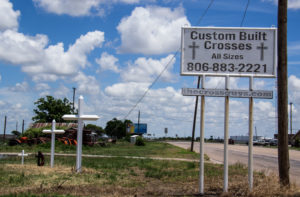
Custom built crosses, all sizes
Custom Built Crosses. All Sizes. The Cross Guys.
If I lived in Texas I would be angry also.
I took this photo in Texas. I guess that’s all I have to say about that.
Like this:
Like Loading...
by aramatzne@gmail.com | 11 Sep 2017 | Musing
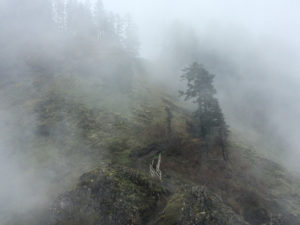
Stairs from the clouds to the clouds, for the clouds.
It is not common to find a perfectly good set of stairs in the clouds on the side of a mountain. Ready to assist any passersby, they stood steady and firm on the landscape.
It was raining but the day was bright and the air mild. Western Oregon is rarely a dry place. I don’t melt. I hiked into the cool, dripping coastal range, eventually climbing high enough that the trees became more scattered, more wind-beaten. The trail, slick with mud, occasionally crossed rock or split around washouts and pools.
I came upon the stairs not far from the mountain peak. Another half mile up a rock face and through twisted semi-alpine plants was the open summit, a granite bald with tortured metal-pipe railing, fully enveloped in cloud.
But the stairs? They were wooden, two by fours and four by eights. There were two sections with a landing and a turn in the middle. The upper section had a handrail on the downslope side, the lower stairs on both sides. The trail by-passed them completely, as if a displeased giant plucked them up, and set them again six feet out of line, but parallel, with the trail.
For 50 years, I was on a known path. It had mud and rocks and unexpected by-passes and washouts but it was well-worn and followed by many. I took this photo the day after my 50th birthday. Since then, I expect stairs in the clouds because they lead to the most amazing of places.
Like this:
Like Loading...
by aramatzne@gmail.com | 10 Sep 2017 | Roads Taken
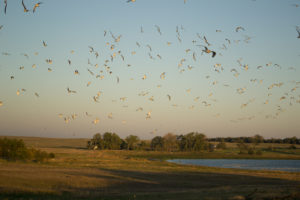
Franklin’s gulls over the apparently misnamed Crow Lake.
You never really know what you’re going to get. Central South Dakota is not exactly a hotspot. I blew through it a few times on the interstate. If you can call five and a half hours blowing through. It was just a necessity of moving from point A to point B. They raised the speed limit to 80 recently. That helps.
For a month one autumn I drove around in circles in central South Dakota. I wasn’t lost or stuck. I was looking for migrating birds. I didn’t find what I was looking for. And that was a good thing. It seems I was the one who should have been migrating.
One evening there was a horde of Franklin’s gulls, on Crow Lake. Naturally. It was dusk, the light was beautiful. In my endless circling, I saw the flocks, pushed by the wind, accumulating in the southern bay. In the air and on the water, they were everywhere.
I took this photo for the light, the motion, and the fluidity of the scene. I returned at dawn, better prepared to photograph the migrating mass, but, in the air or on the water, there were no birds anywhere.
Like this:
Like Loading...
by aramatzne@gmail.com | 9 Sep 2017 | Roads Taken
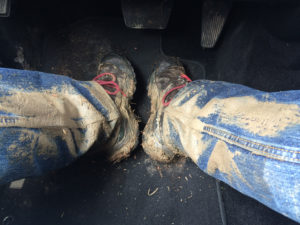
Displaying my fashion sense, I wear North Dakota.
There were two signs on the front of the building. The more prominent sign did not declare 2 7/8 as the name of the bar, but, rather, said, “ZERO TOLERANCE TO FIGHTING ON 2 7/8 PREMISES.” Welcome to fracking-boomtown North Dakota. I drove by.
That evening a massive thunderstorm piled up along the horizon, clouds towering above open plains, building strength, collecting moisture. Until, in the deepest dark of a moonless night, they had enough and let loose.
The Great Plains create some pretty vivid thunderstorms; this was a beauty. Lightning exploded across town in so many consecutive flashes I could see the length of the main street clearly for several seconds. Not just the blink of an eye that leaves you blinded and wondering if the light had been there at all, these flashes lingered. Clearly jumping from cloud to cloud and ground to cloud, there was constant light. The thunder kept pace, a steady rumble in the background with skull-crushing claps in between.
Then the rain came, pounding on the roof two stories above. The parking lot under my window disappeared behind the downpour, truck tires several inches deep in standing rain, as the drains overloaded.
The storm raged for what seemed hours, eventually tapering off as it moved across the open landscape. I fell back into fitful sleep for too few hours.
Many places become entirely inaccessible after a storm like this. Dirt roads turn to what we called Gumbo in Montana. Red dust, yellow dust, brown dirt, it’s all the same after a night like that, bacon-greased ball bearings. The collective hangover of too much.
Enter, the fracking industry, with its heavily graded and graveled roads that go everywhere, and took me where I needed to go that day. I don’t recall what I was surveying, plants or birds. I remember the landscape, wet and misty from the night’s excess. And, I remember repeatedly scraping mud from the bottom of my boots as I slid through the morning’s work. I took this photo when I realized I was wearing a large chunk of North Dakota. With my newly established fashion sense, I might fit in at the 2 7/8.
Like this:
Like Loading...
by aramatzne@gmail.com | 8 Sep 2017 | Roads Taken
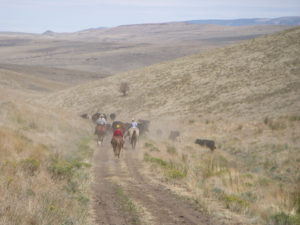
A small boy on a big horse moving cows in the Pueblo Mountains
Three riders moved slowly across the landscape, deliberately but unhurriedly they paralleled my path in the opposite direction. I watched the horses with some envy as I continued on foot.
It was July in the Pueblo Mountains. It was hot. I had been walking since dawn; it was midday now. I was out of water, out of food, and out of patience with the shadeless glare of sun-soaked sagebrush.
From a long way off I could see the horse. Even from a distance, I could tell it was a big horse. The rider was just a red dot. Eventually, the red dot became a person, a boy. He rode a few loops, lazy figure eights. He backed up the horse, made it stand and side step. Then he just sat and watched me approach.
“Where’s your horse?” the boy asked with unaffected curiosity and genuine concern.
“I don’t have one.”
“How far did you walk?”
“I don’t know. Several miles. I started at sunrise.”
“That’s a long time without a horse.”
“Yes.” We stood a minute, he on his horse, me looking at the ground. Then, diverting him from my obvious failing, “That’s a big horse.”
“I know. 17 hands. My dad told me I had to grow enough to get on him by myself before I could ride him. I’m only 7. I can’t grow that fast.”
“But you’re riding him.”
“Yup. I told my dad he better build me a ladder.”
“Did he?”
“Yup.”
“I saw three riders earlier. Was your dad one of them?”
“Yup. And my mom and sister. They said I wasn’t big enough to muster so I had to sit here and wait for them to push the cows to me. Then I can circle and ride them down the hill. We’re moving them to water.”
“You’re not big enough to muster but you’re big enough to sit this giant horse out here by yourself for however many hours it takes for them to come back?”
“I know. That’s what I said. But I lost that argument. If it wasn’t for you, I wouldn’t have anything to do.”
“You need a book.”
“I know.”
I had miles yet to cover and parted company. He sat his horse and watched me walk on.
Later in the afternoon, I watched from a slope above as the cows came, moving ahead of the three riders. The boy rode to meet them, swinging far to one side of the cows and then falling in with the other riders. He waved as he passed below me. And I took this photo of him, his mom and sister, the dust, and the cows, a scene of the west.
Like this:
Like Loading...
by aramatzne@gmail.com | 9 Aug 2017 | Musing
Extirpated from the wild in most of Africa, I had the good fortune to see black rhinoceroses on a private preserve in Zimbabwe last year.
Finding them after dark, a spotlight illuminated a calf scampering about behind its placidly eating mother. Her horns were cut off to deter poaching and the animals are under 24-hour armed guard.
The black rhino population dropped from an estimate of several hundred thousand in the early 1900s to 2,410 by the late 1990s. The primary cause for this decline is poaching. Several subspecies are extinct.
These photos are fuzzy and full of nighttime darkness and shadows. At first, I was disappointed by them. A year later, they seem to appropriately suit their state in the world.
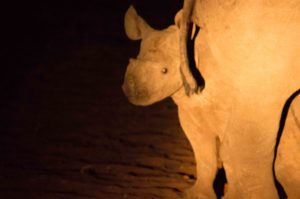
Wary of the light and strangers, a rhino calf hides behind its mother.
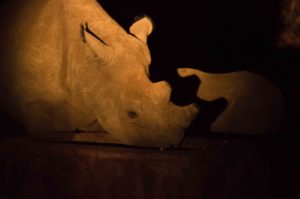
The mama rhino has been dehorned as a measure of protection against poaching. Her dehorned shadow is visible on her calf’s side as it moves behind her.
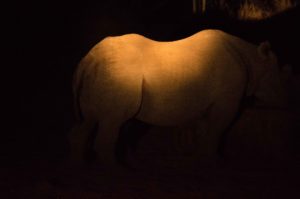
Rhino back, fade to black. What will the world be without rhinos?
Like this:
Like Loading...












